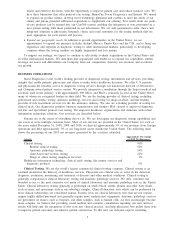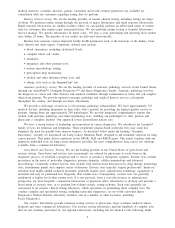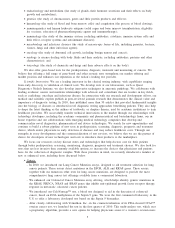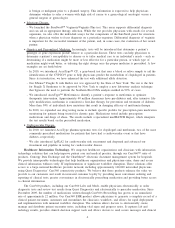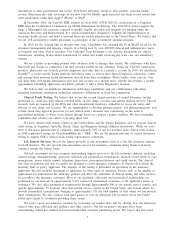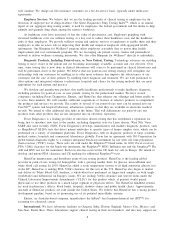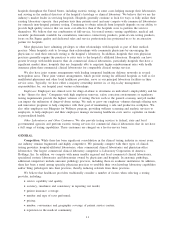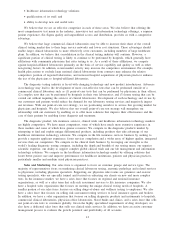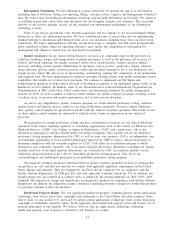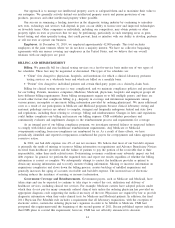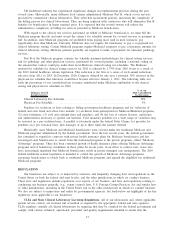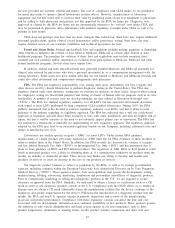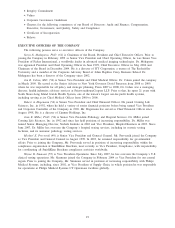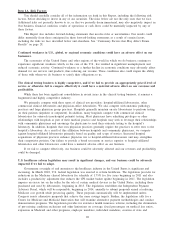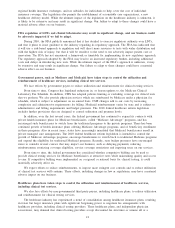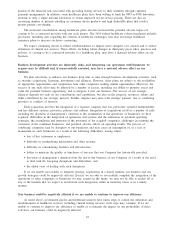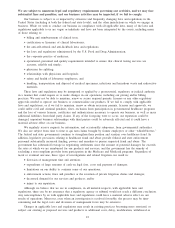Quest Diagnostics 2010 Annual Report Download - page 16
Download and view the complete annual report
Please find page 16 of the 2010 Quest Diagnostics annual report below. You can navigate through the pages in the report by either clicking on the pages listed below, or by using the keyword search tool below to find specific information within the annual report.Information Technology. We use information systems extensively in virtually all aspects of our business,
including clinical laboratory testing, test reporting, billing, customer service, logistics and management of medical
data. We believe that our healthcare information technology systems help differentiate us favorably. We endeavor
to establish systems that create value and efficiencies for our Company, patients and customers. The successful
delivery of our services depends, in part, on the continued and uninterrupted performance of our information
technology systems.
Some of our historic growth has come through acquisitions and we continue to use non-standardized billing,
laboratory or other core information systems. We have standardized some of our systems and are implementing
standard laboratory information and billing systems across our operations, including those from our most recent
acquisitions. We expect implementation will take several more years to complete, and will result in significantly
more centralized systems, improved operating efficiency, more timely and comprehensive information for
management and enhanced control over our operational environment.
Quality Assurance. In our clinical testing business, our goal is to continually improve the processes for
collection, handling, storage and transportation of patient specimens, as well as the precision and accuracy of
analysis and result reporting. Our quality assurance efforts focus on pre-analytic, analytic and post-analytic
processes, including positive patient identification of specimens, report accuracy, proficiency testing, reference
range relevance, process audits, statistical process control and personnel training for all of our laboratories and
patient service centers. We also focus on the licensing, credentialing, training and competence of our professional
and technical staff. We have implemented an enhanced specimen tracking system, with global positioning system
capabilities, that enables us to better track specimens. We continue to implement our Six Sigma and
standardization initiatives to help achieve our goal of becoming recognized as the undisputed quality leader in the
healthcare services industry. In addition, some of our laboratories have achieved International Organization for
Standardization, or ISO, certification. These certifications are international standards for quality management
systems. In 2010, we took a number of steps to further enhance our quality assurance program, including actions
to reduce errors, to measure and monitor performance and to drive process discipline.
As part of our comprehensive quality assurance program, we utilize internal proficiency testing, extensive
quality control and rigorous process audits for our clinical laboratory operations. For most clinical laboratory
tests, quality control samples are processed in parallel with the analysis of patient specimens. The results of tests
on these quality control samples are monitored to identify trends, biases or imprecision in our analytical
processes.
We participate in external proficiency testing and have accreditation or licenses for our clinical laboratory
operations from various regulatory agencies or accrediting organizations, such as the Centers for Medicare and
Medicaid Services (“CMS”), the College of American Pathologists (“CAP”) and certain states. All of our
laboratories participate in various external quality surveillance programs. They include, but are not limited to,
proficiency testing programs administered by CAP, as well as some state agencies. CAP is an independent, non-
governmental organization of board-certified pathologists approved by CMS to inspect clinical laboratories to
determine compliance with the standards required by CLIA. CAP offers an accreditation program to which
laboratories may voluntarily subscribe. All of our major regional and esoteric laboratories, including our facility
in India, and most of our rapid response laboratories, are accredited by CAP. Accreditation includes on-site
inspections and participation in the CAP (or equivalent) proficiency testing program. Also, all of our
cytotechnologists and pathologists participate in an individual proficiency testing program.
Our diagnostic products businesses maintain extensive quality assurance programs focused on ensuring that
our products are safe and effective and that we comply with applicable regulatory requirements in the United
States, Europe and Australia. They are regulated by the FDA and are required to be in compliance with the
Quality Systems Regulations, 21 CFR part 820, and with applicable standards outside the U.S. In addition, our
manufacturing sites are certified in accordance with, or audited by the deemed authority for, ISO 13485: 2003
standards. We endeavor to design and manufacture our diagnostics products in compliance with Quality Systems
Regulations. In addition, the diagnostics products businesses maintain procedures designed to ensure that products
we purchase conform to their specifications.
Intellectual Property Rights. We own significant intellectual property, including patents, patent applications,
technology, trade secrets, know-how, copyrights and trademarks in the United States and other countries. From
time to time, we also license U.S. and non-U.S. patents, patent applications, technology, trade secrets, know-how,
copyrights or trademarks owned by others. In the aggregate, these intellectual property assets and licenses are of
material importance to our business. We believe, however, that no single patent, technology, trademark,
intellectual property asset or license is material to our business as a whole.
13


